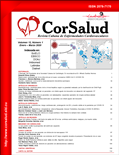Torsade de pointes in a patient with VVI pacemaker dysfunction
Abstract
Torsade de pointes is a clinically important ventricular tachyarrhythmia that typically appears in the presence of a long QT interval and which, without prompt identification and treatment, can lead to sudden cardiac death. The prolongation of QT and corrected QT intervals significantly increases the chance of this arrhythmia to appear in congenital or acquired long QT syndromes. In almost all patients, these intervals are markedly long in the period prior to the arrhythmic event. We describe a case of a female patient with a pacemaker who presented this arrhythmia and suffered several syncopal events.Downloads
References
1. Tester DJ, Ackerman MJ. The molecular autopsy: should the evaluation continue after the funeral? Pediatr Cardiol. 2012;33(3):461-70.
2. Tester DJ, Medeiros-Domingo A, Will ML, Haglund CM, Ackerman MJ. Cardiac channel molecular autopsy: insights from 173 consecutive cases of autopsy-negative sudden unexplained death referred for postmortem genetic testing. Mayo Clin Proc. 2012;87(6):524-39.
3. Arnestad M, Crotti L, Rognum TO, Insolia R, Pedrazzini M, Ferrandi C, et al. Prevalence of long-QT syndrome gene variants in sudden infant death syndrome. Circulation. 2007;115(3):361-7.
4. Van Norstrand DW, Ackerman MJ. Sudden infant death syndrome: do ion channels play a role? Heart Rhythm. 2009;6(2):272-8.
5. Contreras E, Gómez JE, Zuluaga SX. Síndrome de QT largo. Rev Colomb Cardiol. 2008;15(1):12-7.
6. Sovari AA, Kocheril AG, Assadi R, Baas AS. Long QT Syndrome [Internet]. Medscape: e-medicine [citado 29 Ene 2019]; 2017. Disponible en: https://emedicine.medscape.com/article/157826-overview#a3
7. Roden DM. Long QT syndrome: reduced repolarization reserve and the genetic link. J Intern Med. 2006;259(1):59-69.
8. Fitzgerald PT, Ackerman MJ. Drug-induced torsades de pointes: the evolving role of pharmacogenetics. Heart Rhythm. 2005;2(2 Suppl):S30-7.
9. Modell SM, Lehmann MH. The long QT syndrome family of cardiac ion channelopathies: a HuGE review. Genet Med. 2006;8(3):143-55.
10. Dessertenne F. La tachycardie ventriculaire ? deux foyers opposés variables. Arch Mal Coeur Vaiss. 1966;59(2):263-72.
11. Dessertenne F, Fablato A, Coumel P. Un chapitre nouveau d'electrocardiographie: Les variations progressive de l'amplitude de l'electrocardiogramme. Actual Cardiol Angeiol Int. 1966;15:241-58.
12. Keren A, Tzivoni D, Gavish D, Levi J, Gottlieb S, Benhorin J, et al. Etiology, warning signs and therapy of torsade de pointes. A study of 10 patients. Circulation. 1981;64(6):1167-74.
13. Kay GN, Plumb VJ, Arciniegas JG, Henthorn RW, Waldo AL. Torsade de pointes: the long-short initiating sequence and other clinical features: observations in 32 patients. J Am Coll Cardiol. 1983;2(5):806-17.
14. Curry P, Fitchett D, Stubbs W, Krikler D. Ventricular arrhythmias and hypokalaemia. Lancet. 1976;2(7979):231-3.
15. Surawicz B. Is hypomagnesemia or magnesium deficiency arrhythmogenic? J Am Coll Cardiol. 1989;14(4):1093-6.
16. Leonard CE, Brensinger CM, Aquilante CL, Bilker WB, Boudreau DM, Deo R, et al. Comparative safety of sulfonylureas and the risk of sudden cardiac arrest and ventricular arrhythmia. Diabetes Care. 2018;41(4):713-22.
17. Rados DV, Pinto LC, Remonti LR, Leitão CB, Gross JL. (2016) The Association between sulfonylurea use and all-cause and cardiovascular mortality: A meta-analysis with trial sequential analysis of randomized clinical trials. PLoS Med [Internet]. 2016 [citado 2 Feb 2019] 13(4):e1001992. Disponible en: https://www.ncbi.nlm.nih.gov/pmc/articles/PMC4829174/pdf/pmed.1001992.pdf
18. Palanca V, Navarro A, Jiménez J, Quesada A, Morell S, Roda J. Infrasensado auricular intermitente de marcapasos VDD en pacientes con repolarización sensible a bradicardia: un potencial mecanismo de arritmias ventriculares. Rev Esp Cardiol. 2010;63(2):229-32.
19. Perz S, Küfner R, Meisinger C, Ziegler D, Englmeier KH, and members of the KORA Study Group. The effect of different QT interval corrections for heart rate on the QT distributions in diabetics and non-diabetic subjects. Beitrge zur 38. Jahrestagung der Deutschen Gesellschaft fr Biomedizinische Technik im VDE BMT 2004, TU Ilmenau, 22-24/09/2004. Biomedizinische Technik 2004;49(Ergnzungsband 2):296-7.
Downloads
Published
How to Cite
Issue
Section
License
Authors who publish with this journal agree to the following terms:- Authors retain copyright and grant the journal right of first publication with the work simultaneously licensed under a Creative Commons Attribution License that allows others to share the work with an acknowledgement of the work's authorship and initial publication in this journal.
- Authors are able to enter into separate, additional contractual arrangements for the non-exclusive distribution of the journal's published version of the work (e.g., post it to an institutional repository or publish it in a book), with an acknowledgement of its initial publication in this journal.










